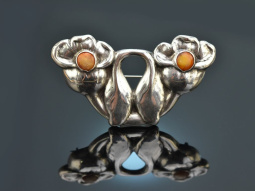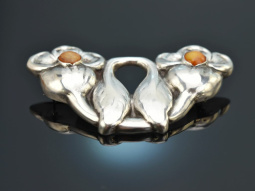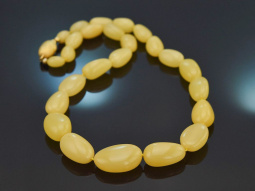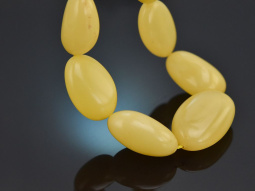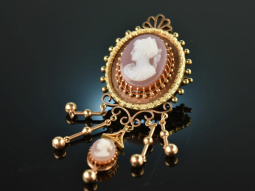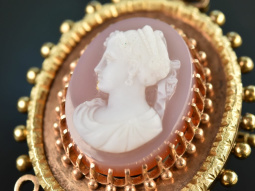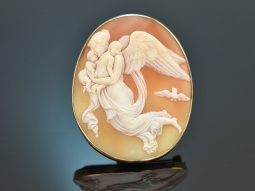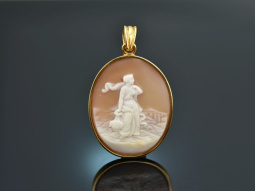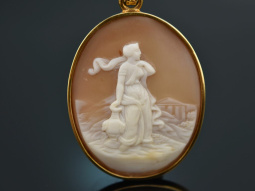Shell, Jet & Amber
Aside from gemstones, other natural materials also offer great potential for jewellery production. For example, cult objects and jewellery have been made from shell, jett and amber since ancient times - sometimes even since the beginning of human history. Discover our most beautiful objects made from these unique organic materials here. Learn more »
Shell cameos: virtuoso works of art in small spaces
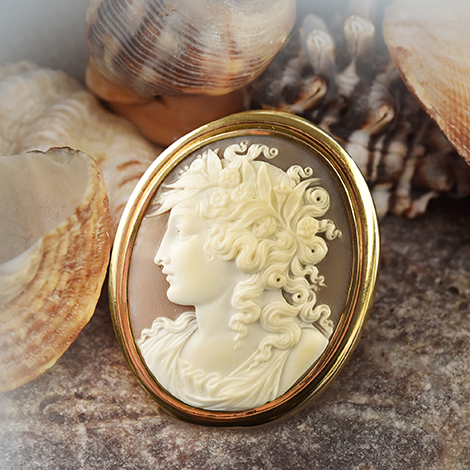
Jewellery made from shell allows us to share in the masterly craftsmanship of times gone by, as shell carving reached its first peak as early as the time of Roman antiquity and continued to be fashionable in the centuries that followed.
There are three different terms when dealing with this topic: While „gem“ is to be understood as a collective term for engraved gemstones, „cameo“ refers to a raised stone cut in relief. With an intaglio, on the other hand, the motif is engraved into the surface (see signet rings).
Agate, carnelian and shell have always been established as the base material for gems. Due to its natural layering, the latter offers the best conditions for depicting the desired scenes in high contrast. The cut motif is carved out of the white layer of the shell - from a biological point of view, this should actually be referred to as a snail - and is then presented on a brown background.
Shell cameos very often depict images of gods and rulers as well as mythological scenes or antique-style portraits of women.
Most of our cameos date from the second half of the 19th century, when the art of bygone eras was received in historicism and shell jewelry was once again of great importance. The heyday of gems finally came to an end in the 20th century.
Jet: treasure from the earth
Jet (also known as gagate) is a deep black fossil wood that is very easy to work with and has been used to make jewellery since prehistoric times. However, jewellery made from jet reached its absolute peak in the 19th century as mourning jewellery. The centre of this movement was the port town of Whitby in northern England. It is still regarded as the most important place where the black material was found.
At this time, the English cultivated an excessive cult of mourning, which intensified with the death of Prince Albert in 1861. However, with the death of Queen Victoria (1901) at the latest, fresher jewellery designs were preferred and Jett jewellery was passé.

When gagate is polished, it takes on a beautiful shine, which made small and large jewellery objects even more attractive. The lightness of the material also allowed the production of opulent, expansive antique jewellery that was still comfortable to wear. Apart from mourning jewellery, gagat was very popular for multi-row necklaces, medallions or brooches.
Amber: golden sheen and a lively interior
Amber can also be dated back to the Paleolithic Age in the form of beads and small pendants as an object of jewellery and still delights us today with its honey-golden lustre and the unique interplay of light and colour that it creates.
Amber is a fossilised resin that has been shaped over millions of years by pressure and weather. Foreign bodies, small animals and plants can become trapped in the resin as it emerges from the tree bark, resulting in spectacular finds and inclusions in amber.
Each of the warmly glowing stones is therefore a truly unique piece and can certainly be regarded as a witness to a long-gone era. Amber jewellery is extremely versatile, as it is not only particularly attractive due to its organic shape, but also offers a broad colour palette: the stones can be opaque or translucent, their palette ranges from dark brown to cognac and caramel shades to honey-coloured and yellowish-white variants. Modern amber jewellery can therefore be made in a wide variety of styles to suit your own taste.
